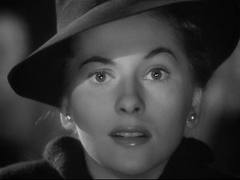Joan Fontaine 1917–2013
Joan Fontaine liked to say, “I hope I’ll die on stage at the age at 105, playing Peter Pan.” She nearly got her wish. The death of the actress who made a name for herself in Rebecca and won an Oscar the following year for Suspicion, was confirmed this evening by The Hollywood Reporter. She was 96 and died at home of natural causes.
Fontaine, the cultivated English rose who was actually born in Japan, was daughter of an English father and an American mother. She was one of the last links to Hollywood’s Golden Age. The last is Olivia de Havilland, Fontaine’s older sister, 97. Famous for their talent and radiant beauty, the sisters were infamous for a longstanding feud that de Havilland declined to confirm and Fontaine liked to talk about. She once explained the feud was due to her getting married first, winning an Oscar nomination and an Oscar before her sister did. When she and her sister were children, Fontaine wrote a will that read, “I bequeath my beauty to my sister,because she has none.” A reliable source tells me that during the last few years the sisters were speaking.)
Slim as the stem of a champagne flute and graced with a rosebud mouth and disproportionately large, expressive eyes, Fontaine made her movie debut at 18 in No More Ladies (1935). Two years later she was Fred Astaire’s amiably anxious co-star in Damsel in Distress, a movie title that aptly describes her most famous roles. After a small role as an admirably fertile young housewife in The Women (1939) Alfred Hitchcock tapped her to play the second Mrs. DeWinter opposite Laurence Olivier in Rebecca (1940), an astonishing performance in which she seems to shrink amid the grandeur of her husband and his manor. Like a silent movie actress, Fontaine’s face communicated her character’s vulnerability more eloquently than dialogue could. With the exception of Lillian Gish, no one did vulnerable like Fontaine.
Rebecca earned Fontaine her first, and much deserved, Oscar nomination. She would win the following year for Hitchcock’s Suspicion, in which she played a well-bred Englishwoman who worries that her husband (Cary Grant) is trying to poison her for her fortune. She was lovely as the teenager moonstruck by older composer Charles Boyer in The Constant Nymph (1943) and a trembling Jane Eyre (1944) opposite Orson Welles. Most cinephiles would agree that her greatest performance was as the young woman besotted with musician Louis Jourdan in Max Ophuls’ Letter from an Unknown Woman (1948).
After her Oscar, she frequently played brittle sophisticates. This was an archetype she played with élan when she was more mature, as in Ida Lupino’s The Bigamist (1953) and Henry King’s Tender is the Night (1962).
She was married four times: to actor Brian Aherne (1939–45); to producer William Dozier (1946-51); to producer Collier Young (1952-1961) and to businessman Alfred Wright, Jr. (1964-69). She had a daughter, Deborah, with Dozier and adopted a daughter, Martita, from Peru in 1952. As a teenager Martita went back to Peru and refused contact with her adoptive mother.
By all reports, Fontaine was a first-class gardener, a cordon bleu chef and was much- celebrated for her interior decorating. She wrote a memoir, No Bed of Roses. Her second husband dubbed it “no shred of truth.”
Her favorite among her films was The Constant Nymph. Yours?




The ultimate English rose was born in Japan. Joan Fontaine 1917–2013… http://t.co/CgETNjdaIv
RT @CarrieRickey: The ultimate English rose was born in Japan. Joan Fontaine 1917–2013… http://t.co/CgETNjdaIv
@ScottFeinberg Thanks for the confirmation of JF’s passing. My thoughts: http://t.co/8av82TiAC2 That Koufax pic made me cry.
RT @CarrieRickey: The ultimate English rose was born in Japan. Joan Fontaine 1917–2013… http://t.co/XmyldmrwcH
RT @CarrieRickey: The ultimate English rose was born in Japan. Joan Fontaine 1917–2013… http://t.co/CgETNjdaIv
???? Joan Fontaine. “@CarrieRickey: The ultimate English rose was born in Japan. Joan Fontaine 1917–2013… http://t.co/KpVXo6OgNG” #RIP
Also @CarrieRickey says a “reliable source” told her Joan Fontaine & Olivia de Havilland were speaking in recent yrs. http://t.co/cFxAyreo6J
RT @selfstyledsiren: Also @CarrieRickey says a “reliable source” told her Joan Fontaine & Olivia de Havilland were speaking in recent yrs. …
RT @selfstyledsiren: Also @CarrieRickey says a “reliable source” told her Joan Fontaine & Olivia de Havilland were speaking in recent yrs. …
RT @selfstyledsiren: Also @CarrieRickey says a “reliable source” told her Joan Fontaine & Olivia de Havilland were speaking in recent yrs. …
RT @selfstyledsiren: Also @CarrieRickey says a “reliable source” told her Joan Fontaine & Olivia de Havilland were speaking in recent yrs. …
RT @selfstyledsiren: Also @CarrieRickey says a “reliable source” told her Joan Fontaine & Olivia de Havilland were speaking in recent yrs. …
RT @selfstyledsiren: Also @CarrieRickey says a “reliable source” told her Joan Fontaine & Olivia de Havilland were speaking in recent yrs. …
RT @selfstyledsiren: Also @CarrieRickey says a “reliable source” told her Joan Fontaine & Olivia de Havilland were speaking in recent yrs. …
RT @selfstyledsiren: Also @CarrieRickey says a “reliable source” told her Joan Fontaine & Olivia de Havilland were speaking in recent yrs. …
RT @selfstyledsiren: Also @CarrieRickey says a “reliable source” told her Joan Fontaine & Olivia de Havilland were speaking in recent yrs. …
RT @selfstyledsiren: Also @CarrieRickey says a “reliable source” told her Joan Fontaine & Olivia de Havilland were speaking in recent yrs. …
RT @selfstyledsiren: Also @CarrieRickey says a “reliable source” told her Joan Fontaine & Olivia de Havilland were speaking in recent yrs. …
RT @selfstyledsiren: Also @CarrieRickey says a “reliable source” told her Joan Fontaine & Olivia de Havilland were speaking in recent yrs. …